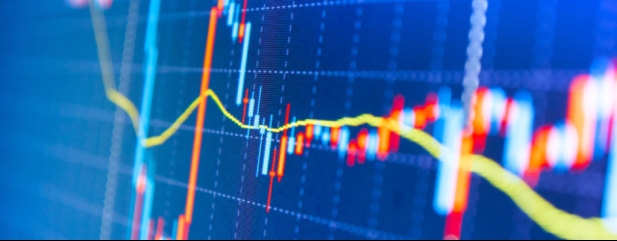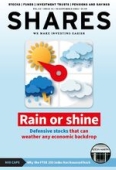Archived article
Please note that tax, investment, pension and ISA rules can change and the information and any views contained in this article may now be inaccurate.
Find out why stock markets have not fully factored in rising rates

As reflected in the underperformance of the technology heavy Nasdaq Composite index, high growth shares are sensitive to interest rates due to the fact a big chunk of their value is based on cash flows far into the future.
It’s not just growth shares though, all shares are impacted by rising interest rates through the mechanism of a higher discount rate.
But have markets discounted the full impact of higher rates? Arguably, falls of 1% in the FTSE 100, 18% in the DAX and 20% in the S&P 500 over the past 12 months look tame relative to the quantum leap in interest rates.
Market strategists at Morgan Stanley and Goldman Sachs are in the camp arguing for a bigger market derating before a market bottom has been reached.
This article takes a closer look at the dynamics of discounted cash flow and the findings suggest markets are vulnerable to further erosion in the ratings at which stocks trade.
DISCOUNTED CASH FLOW
Discounted cash flow is a common investment approach used to value companies in the stock market. It is based on shareholders’ claims on a firm’s cash flows.
The idea is to add up estimated future cash flows, discount them back to a ‘present value’ and compare it with the current share price. If the price is below the value of a firm’s discounted cash flows, the share is cheap and vice-versa.
WHY ARE CASH FLOWS DISCOUNTED?
Future cash flows are discounted (reduced) for two reasons; first, because of the uncertainty of them occurring and second, due to the opportunity cost of capital.
Opportunity cost refers to the idea that if the capital is not invested in shares, it could earn a risk-free rate of return in government bonds.
WHAT IS AN APPROPRIATE DISCOUNT RATE?
To answer the question some context is needed because the discount rate is comprised of a risk-free rate and a risk premium, which are explained below. But first, some context.
Up until 2021, government bonds yielded close to zero, even at the 10-year investment horizon, and many bonds traded with negative yields. It may sound crazy today but not long ago, investors were willing to pay borrowers to lend them money.
Ultra-loose monetary policy led to a cost of capital which was virtually zero. But historically 10-year bond yields have traded on average at close to 4% in most developed economies.
Theoretically, zero risk-free rates reduce the return that investors expect to receive which makes higher growth shares more valuable. This was a strong driver of rising price to earnings ratios for growth companies.
Investors were happy to pay 30, 40 or even 50 times expected earnings to own a stock that offered the promise of rapid growth in the future. Today they are less willing to pay such multiples of earnings.
RISK PREMIUM
The risk premium is related to the idea that investors in shares demand a higher return than bonds because they are taking more risk.
The equity – which is another word for stocks and shares – risk premium is measured by comparing long-term share and government bond returns. Historical studies have shown the extra annual return earned by shares has ranged between 4% and 6%.
WHAT DOES A RISING DISCOUNT DO TO SHARE VALUATIONS?
Ten-year bond yields (i.e., risk-free rates) have increased by up to four percentage points in the US and UK over the last year. Assuming the risk premium has remained the same then taking the mid-point of the historical average (5%) implies a four-percentage point increase in the discount rate to 9%.
To illustrate the impact of a four-percentage point increase in the cost of capital for a growth company, Shares has used an annual growth rate of 15% for cash flows over a 10-year time horizon.
Growth at 15% means £100 of cash flow will quadruple over 10 years. The rule of 70 can be helpful here. Simply divide the growth rate (15%) into 70 to estimate how many years it would take to double.
The answer is roughly five years, which means over 10 years the cash flow will double again. Each year’s cash flow must be discounted by the 5% rate, compounded each year.
As illustrated in the table, in year one cash flow of £115 is discount by 5% (divided by 1.05), year two cash flow of £132 is discounted by 1.05x1.05=1.1025 and so on.
Present value cash flows are then calculated. The year 10 discount rate is 1.6289 which reduces the value of that year’s cash flow by around 40% to £248.
Total cash flows add up to £1,706. Remember, cash flows can theoretically go on forever, so a value needs to be placed on them.
The simplest way is to do this is to perform a perpetuity calculation. Year 10 cash flow is multiplied by the inverse of the discount rate (5% = 20 times) and then divided by the year 10 discount rate of 1.6289.
The process is repeated using 9% cost of equity and table two shows the present value falls by half. Also note the bulk of the fall sits in the perpetuity calculation. In other words, cash flows far into the future are impacted the most.
Important information:
These articles are provided by Shares magazine which is published by AJ Bell Media, a part of AJ Bell. Shares is not written by AJ Bell.
Shares is provided for your general information and use and is not a personal recommendation to invest. It is not intended to be relied upon by you in making or not making any investment decisions. The investments referred to in these articles will not be suitable for all investors. If in doubt please seek appropriate independent financial advice.
Investors acting on the information in these articles do so at their own risk and AJ Bell Media and its staff do not accept liability for losses suffered by investors as a result of their investment decisions.
Issue contents
Feature
Great Ideas
News
- Mid-cap stocks reverse losing streak versus FTSE 100
- Why retail investors in JPMorgan Russian Securities are sounding the alarm on changes
- Veterinary group CVS plans to double profitability over the next five years
- Falling house prices and higher sales cancellations: why property market-related shares are down again
- Chinese stocks surge on prospect of end to strict Covid measures
- Hasbro hurt as toy demand drops following price hikes
- Strong customer demand puts Caterpillar shares 10% ahead on the year

 magazine
magazine








